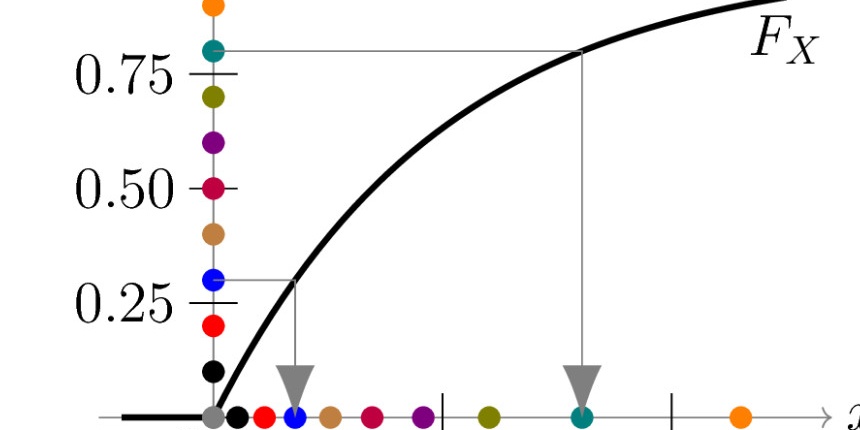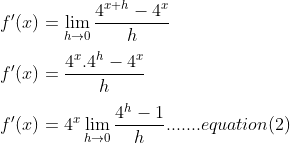JEE Main: Differentiation and How To Calculate ‘e’
We all have come across the number ‘e’ while studying logarithm and calculus. This number is an irrational number like π, and is called Euler’s Number. Its value is 2.71828… and this sequence of digits never ends. So, how can we find this number and what is so special about this number?

A property that you must have studied in differentiation that stands out among all differentiation formulae is

So, the differentiation of the function f(x) = ex, is this function itself. This makes this function unique. We will be using this property to calculate the number ‘e’. So, in all the calculations below, we will not use ‘e’ directly.
Let us start with the differentiation of a general exponential function, f(x) = 2x.
Using First Principle of Differentiation, we know that the differentiation of a function f(x) is

So, differentiation of f(x) = 2x will be

Now, when the value of the limit h→0 [(2h-1)/h] is calculated by putting different values of h that are very close to 0, we can see that the value of this expression approaches 0.693147…(Note that we are not directly using the value of this limit as ln(2), as the number ‘e’ and thus ln(x), which is log with the base ‘e’, is not yet known).
Also Read,
- JEE Main: How To Prepare At Home, Without Spending A Paisa
- Learn About Happy Hormones For NEET
- How To Help Your Child Nurture Their Mental Health
- VITEEE, JEE Main: One Prep, Ace Both
Let us see what values of [(2h-1)/h] we get by putting different values of h that are close to 0. We can use a calculator to find these values
When h = 0.001, [(2h-1)/h] = 0.6933…
When h = 0.0001, [(2h-1)/h] = 0.6931…
When h = 0.00000001, [(2h-1)/h] = 0.6931…
We can see that [(2h-1)/h] value approaches 0.6931…and hence
limit h→0 [(2h-1)/h]= 0.6931…
From equation (i):
f'(x) = 2x.(0.6931…)
So, differentiation of f(x) = 2x is of the form
f'(x) = Some constant. f(x)
Now if we do the same procedure with f(x) = 4x

When h = 0.001, [(4h-1)/h] = 1.3872…..
When h = 0.0001, [(4h-1)/h] = 1.38631…
When h = 0.00000001, [(4h-1)/h] = 1.38629…
So, limit h→0 [(4h-1)/h] = 1.38629…
And from (ii),
f'(x) = 4x . (1.38629…)
So, differentiation of f(x) = 4x is again of the form
f'(x) = Some constant. f(x)
In fact, we can do the same exercise for any positive real number a, and we will find that the differentiation of f(x) = ax equals some constant times ax
It can also be seen that the value of this constant keeps on increasing as the value of ‘a’ increases. For example
For a = 2, the constant we calculated was 0.6931…
For a = 4, the constant we calculated was 1.38629…
Similarly, for a = 5, the constant can be calculated to be 1.6094…
For a = 6, the constant is 1.7917…
So naturally we can ask ourselves the question that can we find a number ‘a’ for which this constant value equals 1, and thus differentiation of ax is 1. ax, meaning that the differentiation of the function ax is this function itself ( = ax)
After doing multiple hits and trials, this number can be found to be 2.71828. That is why we have the unique property,
d/dx(ex)= ex
Euler’s Number also finds applications in fields of mathematics other than calculus. One of the most important applications is in Complex Numbers. You must have come across the relation eiπ = - 1. Imaginary powers of e help us get the values of many trigonometric series which would otherwise be very difficult to prove using only the trigonometric relations. The number is also used in Finance (to calculate compound interest), to explain population growth of humans or microbes, to explain radioactive decay (which in turn is used to tell the age of ancient objects), etc.
Due to numerous applications, ‘e’ is the second most famous mathematical constant after π. We also celebrate ‘e-day’ on 7 February. This date is chosen as it is written as 2/7 in month/date format and the digits 2,7 represent the first two digits used in the value of ‘e’ (2.71…).
Popular Courses and Specializations
List of colleges accepting JEE Main
Browse Engineering Colleges by State
Questions related to JEE Main
On Question asked by student community
Hello,
Here is your JEE Main Question Papers with Solutions (2025-2016). I am providing you the link. Kindly open and check it out.
-
https://engineering.careers360.com/articles/jee-main-question-papers
- https://engineering.careers360.com/articles/jee-main-answer-key
I hope it will help you.
Thank you.
Hello aspirant,
It is possible to prepare for both JEE (Engineering) and NEET, particularly for Physics and Chemistry, which have a lot of syllabus overlap. However, it takes a lot of commitment, a well-thought-out PCMB (Physics, Chemistry, Biology, Maths) study plan, concentrating on NCERT, and giving Math or Biology priority based on your primary interest because both exams require a lot of practice.
Thank you
Hello
Yes, it creates a problem if you're 12th LC(state OBC) and JEE(Central OBC/EWS) categories differ.
JoSAA requires a central OBC-NCL certificate for OBC reservation; since Karnataka OBC isn't central, you will be treated as general, or you can use a Declaration for OBC-to-General conversions from during counseling, but switching to EWS needs you to have applied as EWS initially. Your EWS certificate works if you meet the income criteria, but yes the important thing is Central OBC list for OBC, not state list.
Hope it helps you, in case of any doubts you can directly drop your query or you can visit to Careers360.com
Hello,
Yes, in JEE Mains, 95 percentile and above is good, and you can get admission in mid to upper-tier NITs. Here is the list of some NITs where you can get admission.
1. NIT Agartala
2. NIT Raipur
3. NIT Durgapur
4. NIT Puducherry
Thank you.
hello,
The link to the most relevant chapter of JEE Mains is attached herewith. You can also find the sample papers with an answer key, which will help you analyse your in-depth performance. Careers360 gives every aspirant an opportunity for a free mock test. the registration is going on. The last date of registration on 8th January.
https://engineering.careers360.com/articles/most-important-chapters-of-jee-main
Thank you.
B.Tech/B.Arch Admissions OPEN
Among top 100 Universities Globally in the Times Higher Education (THE) Interdisciplinary Science Rankings 2026
VIT - VITEEE 2026
ApplyNational level exam conducted by VIT University, Vellore | Ranked #16 by NIRF for Engg. | NAAC A++ Accredited
Amrita University B.Tech 2026
ApplyRecognized as Institute of Eminence by Govt. of India | NAAC ‘A++’ Grade | Upto 75% Scholarships
UPES B.Tech Admissions 2026
ApplyRanked #43 among Engineering colleges in India by NIRF | Highest Package 1.3 CR , 100% Placements
Jain University B.Tech Admissions 2026
Apply100% Placement Record | Highest CTC 54 LPA | NAAC A++ Accredited | Ranked #62 in India by NIRF Ranking 2025 | JEE & JET Scores Accepted
M. S. Ramaiah University B.Tech Admissions 2026
ApplyNAAC A+ & NBA Accredited | QS I-Gauge Gold rated University | Highest CTC 52 LPA | 300+ Companies | Avail Scholarships Application Deadline: 28th Feb’26
